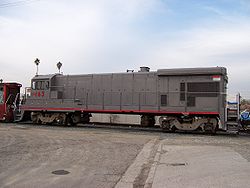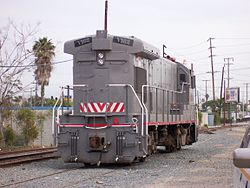Control Car Remote Control Locomotive
- Control Car Remote Control Locomotive
-

UPY 163, showing fuel tank is gone.
A Control Car Remote Control Locomotive (CCRCL) is a stripped diesel locomotive body with remote control equipment installed. The term and the units are a creation of the Union Pacific Railroad, which as of 2005[update] is widely adopting remote control of locomotives in switching service. They are sometimes improperly called slugs, and differ from normal remote control locomotives as they cannot move on their own.
Use
It is coupled to a locomotive (or a consist of locomotives) which lack remote control equipment; it is set to be the lead locomotive in command of the others, controlling them through their multiple unit control connections.
Until all locomotives in switching service are equipped with remote control apparatus, the CCRCLs provide an easy way of ensuring that remote control capability is available. They do not require taking active locomotives out of service to equip them with the remote control capability; instead, this can be added when the locomotive is next scheduled for a normal overhaul.
Conversion
When a locomotive is converted to a CCRCL the traction motors and fuel tank are removed. The windows are plated over, the locomotive is painted gray with red lettering, and remote control equipment is installed. The locomotives used are old GE-built locomotives, models B23-7 and B30-7.[1] These have a low value on the used locomotive market.
References
Sources
- Graham-White, Sean. UP CCRCLs. Retrieved on January 28, 2005.
Categories:
- Rail technologies
- Unmanned ground vehicles
Wikimedia Foundation.
2010.
Look at other dictionaries:
Control car (rail) — Modern German InterCity Steuerwagen cab car. Rail transpo … Wikipedia
Multiple-unit train control — Multiple unit train control, sometimes abbreviated to multiple unit or MU, is a method of simultaneously controlling all the traction equipment in a train from a single location, whether it is a Multiple unit comprising a number of self powered… … Wikipedia
Traffic Control — ➡ law enforcement * * * Introduction supervision of the movement of people, goods, or vehicles to ensure efficiency and safety. Traffic is the movement of people and goods from one location to another. The movement typically occurs… … Universalium
Steam locomotive — A steam locomotive is a locomotive powered by steam. The term usually refers to its use on railways, but can also refer to a road locomotive such as a traction engine or steamroller.Steam locomotives dominated rail traction from the mid 19th… … Wikipedia
Radio control — (often abbreviated to R/C or simply RC) is the use of radio signals to remotely control a device. The term is used frequently to refer to the control of model vehicles from a hand held radio transmitter. Industrial, military, and scientific… … Wikipedia
Distributed power — In rail transport distributed power refers to the placing of additional locomotives at intermediate points in the middle of the train, remotely controlled from the leading locomotive, to allow longer trains where operational considerations or… … Wikipedia
DB Class V 90 — DB Class 290 DBAG Class 290 Also classes 291, 294, 295 ,296 A german class 290 diesel locomotive at Lobenstein station (March 2002) Builder MaK Serial number 290 001 407 also 290 … Wikipedia
Union Pacific Railroad — Infobox SG rail logo filename = Union Pacific Logo.svg logo size=100 system map size = 300 map caption = System map (trackage rights in purple) marks = UP locale = United States from Chicago, Illinois, and cities along the Mississippi River to… … Wikipedia
List of rail accidents (pre-1950) — For a list of 1950 1999 rail accidents, see List of 1950 1999 rail accidents.For a list of post 2000 rail accidents, see List of rail accidents. notoc Pre 1830 1815 * 1815, exact date unclear ndash; Philadelphia, Co Durham, England: 16 people,… … Wikipedia
Slug (railroad) — A railroad slug is an accessory to a diesel electric locomotive. It has trucks with traction motors but is unable to move about under its own power, as it does not contain a prime mover to produce electricity. Instead, it is connected to a… … Wikipedia
 Union Pacific CCRCL Y162 at Anaheim, California.
Union Pacific CCRCL Y162 at Anaheim, California.

